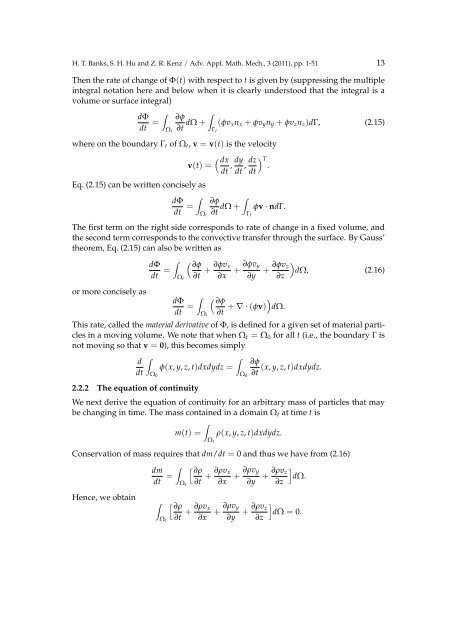A Brief Review of Elasticity and Viscoelasticity for Solids 1 Introduction
A Brief Review of Elasticity and Viscoelasticity for Solids 1 Introduction
A Brief Review of Elasticity and Viscoelasticity for Solids 1 Introduction
You also want an ePaper? Increase the reach of your titles
YUMPU automatically turns print PDFs into web optimized ePapers that Google loves.
H. T. Banks, S. H. Hu <strong>and</strong> Z. R. Kenz / Adv. Appl. Math. Mech., 3 (2011), pp. 1-51 13<br />
Then the rate <strong>of</strong> change <strong>of</strong> Φ(t) with respect to t is given by (suppressing the multiple<br />
integral notation here <strong>and</strong> below when it is clearly understood that the integral is a<br />
volume or surface integral)<br />
∫<br />
∫<br />
dΦ<br />
dt = ∂ϕ<br />
Ω t ∂t dΩ +<br />
where on the boundary Γ t <strong>of</strong> Ω t , v = v(t) is the velocity<br />
v(t) =<br />
Eq. (2.15) can be written concisely as<br />
Γ t<br />
(ϕv x n x + ϕv y n y + ϕv z n z )dΓ, (2.15)<br />
( dx<br />
dt , dy<br />
dt , dz ) T.<br />
dt<br />
∫<br />
∫<br />
dΦ<br />
dt = ∂ϕ<br />
Ω t ∂t dΩ +<br />
Γ t<br />
ϕv · ndΓ.<br />
The first term on the right side corresponds to rate <strong>of</strong> change in a fixed volume, <strong>and</strong><br />
the second term corresponds to the convective transfer through the surface. By Gauss’<br />
theorem, Eq. (2.15) can also be written as<br />
or more concisely as<br />
dΦ<br />
dt = ∫<br />
( ∂ϕ<br />
Ω t ∂t + ∂ϕv x<br />
∂x<br />
+ ∂ϕv y<br />
∂y<br />
∫<br />
dΦ<br />
( ∂ϕ<br />
)<br />
dt = Ω t ∂t + ∇ · (ϕv) dΩ.<br />
+ ∂ϕv )<br />
z<br />
dΩ, (2.16)<br />
∂z<br />
This rate, called the material derivative <strong>of</strong> Φ, is defined <strong>for</strong> a given set <strong>of</strong> material particles<br />
in a moving volume. We note that when Ω t = Ω 0 <strong>for</strong> all t (i.e., the boundary Γ is<br />
not moving so that v = 0), this becomes simply<br />
∫<br />
∫<br />
d<br />
∂ϕ<br />
ϕ(x, y, z, t)dxdydz = (x, y, z, t)dxdydz.<br />
dt Ω 0 Ω 0<br />
∂t<br />
2.2.2 The equation <strong>of</strong> continuity<br />
We next derive the equation <strong>of</strong> continuity <strong>for</strong> an arbitrary mass <strong>of</strong> particles that may<br />
be changing in time. The mass contained in a domain Ω t at time t is<br />
∫<br />
m(t) = ρ(x, y, z, t)dxdydz.<br />
Ω t<br />
Conservation <strong>of</strong> mass requires that dm/dt = 0 <strong>and</strong> thus we have from (2.16)<br />
Hence, we obtain<br />
dm<br />
dt = ∫<br />
∫<br />
[ ∂ρ<br />
Ω t ∂t + ∂ρv x<br />
∂x<br />
[ ∂ρ<br />
Ω t ∂t + ∂ρv x<br />
∂x<br />
+ ∂ρv y<br />
∂y<br />
+ ∂ρv y<br />
∂y<br />
+ ∂ρv ]<br />
z<br />
dΩ.<br />
∂z<br />
+ ∂ρv ]<br />
z<br />
dΩ = 0.<br />
∂z

















